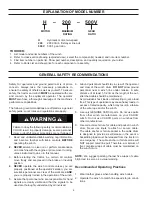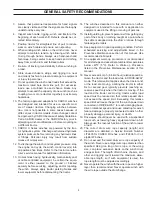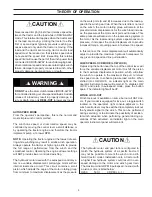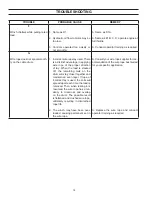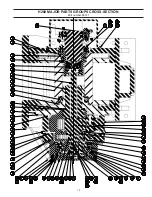
5
3. Assure that personnel responsible for hand signals
are clearly visible and that the signals are thoroughly
understood by everyone.
4. Inspect winch cable, rigging, winch and tractor at the
beginning of each work shift. Defects should be cor-
rected immediately.
5. Position tractor for straightest line of pull to reduce
wear on winch cable and ensure even spooling.
6. When winding winch cable on the winch drum, never
attempt to maintain tension by allowing winch cable
to slip through hands. Always use hand-over-hand
technique, being careful to keep hands and clothing
away from winch drum and fairlead rollers.
7. Be sure of tractor ground stability before winching in
a load.
8. Store unused chokers, slings, and rigging in a neat
and orderly fashion to prevent damage to equipment
or injury to personnel.
9. Do not operate the winch under loads that exceed the
maximum rated bare drum line pull. For excessive
loads, use a multipart line and sheave blocks. Any
attempt to exceed the capacity of one winch (such as
coupling two or more tractors together) is extremely
hazardous.
10. The factory-approved adaptions for CARCO winches
are designed and intended for use on specific mod-
els of crawler tractors. Changing winches between
trac- tors is not possible in some cases because of
differ- ences in tractor models. Some changes cannot
be approved by CARCO because of safety limitations.
Call a CARCO dealer or the CARCO factory prior to
attempting winch modifications or before mounting on
a different tractor.
11. CARCO H Series winches are powered by the trac-
tor hydraulic system. Discharge all retained hydraulic
system pressure before removing any hydraulic lines
or fittings. Personal injury may result from sudden
release of oil pressure.
12. To discharge the winch control system pressure, stop
the engine and cycle the winch control lever(s) into
all positions five times. Refer to the tractor manufac-
turer’s service manual for additional information.
13. On machines having hydraulically, mechanically and/
or cable controlled equipment, be certain the equip-
ment is either lowered to the ground or blocked
securely before servicing, adjusting, and/or repairing
the winch. Always apply tractor parking brakes and
lower equipment before dismounting the tractor.
14. The winches described in this manual are neither
designed nor intended for use with or application to
equipment used in the lifting or moving of persons.
15. Install guarding to prevent personnel from getting any
part of their body or clothing caught at a point where
the cable is wrapped onto the drum or drawn through
fairlead guide rollers.
16. Keep equipment in good operating condition. Perform
scheduled servicing and adjustments listed in the
Preventive Maintenance section of this manual. Use
recommended lubricants.
17. An equipment warm-up procedure is recommended
for all start-ups and essential at ambient temperatures
below +40ºF (5ºC). Refer to Warm-up Procedure
listed in the Preventive Maintenance section of this
manual.
18. Never exceed
4 mph (6.4 km/hour)
relative speed be-
tween the tractor and the load while in DRIVE-AWAY
mode. This relative limit applies when the tractor and/
or the load are moving. Limiting the tractor to either
first or second gear typically prevents reaching ex
-
cessive speed only when the tractor is moving. If the
load and the tractor are moving, tractor and/or load
speed must be reduced so that relative speed does
not exceed the speed limit. Exceeding this relative
speed limit will cause the part of the winch power train
connected in DRIVE-AWAY to reach damaging back-
driven rotational speed and cause catastrophic winch
failure, damage to property connected to winch, other
property damage, personal injury, or death.
19. Drive-away should never be used with a suspended
load, such as lowering heavy equipment down a hill.
Always use the reel-out function of the winch to lower
a load.
20.
The correct drum wire rope capacity (length) and
diameter are detailed in Service Bulletin Number
LIT2435 for CARCO Winches, and LIT2436 for Cat-
erpillar Winches.
21. Do not exceed the rated drum wire rope capacity of
the winch. Never use a larger wire rope diameter than
specified. Using too long of wire rope, or the wrong
size, can place excessive loads on the winch drum
and gear train. The length of tail chains, chokers, and
other end rigging count toward the maximum allow-
able rope length, so if such equipment is used, the
rope length must be adjusted accordingly.
22. Never operate the winch with the wire rope on a higher
layer than recommended. Never operate winch with
the wire rope outside the drum flange.
GENERAL SAFETY RECOMMENDATIONS




